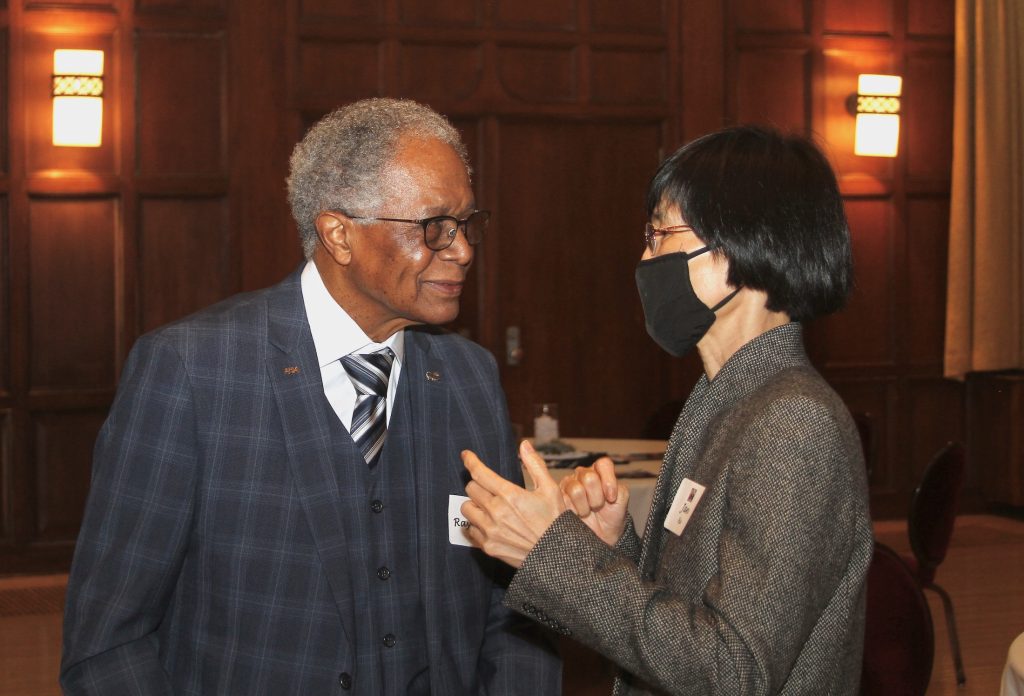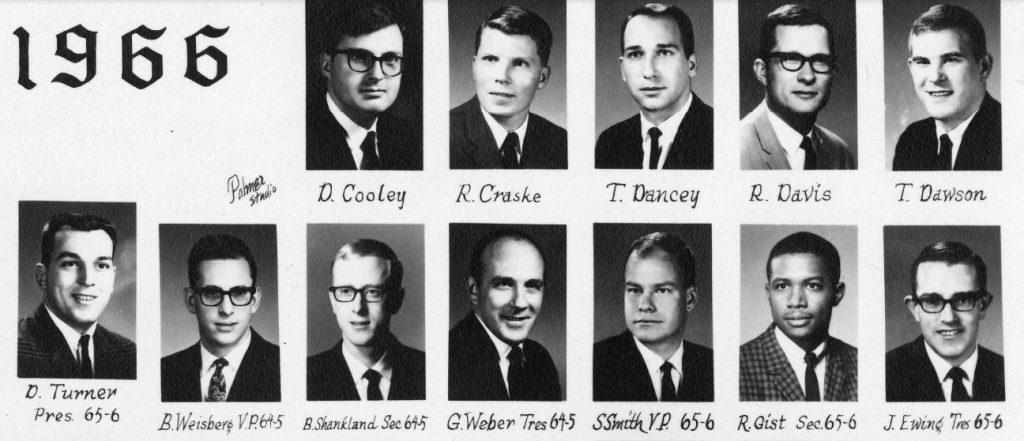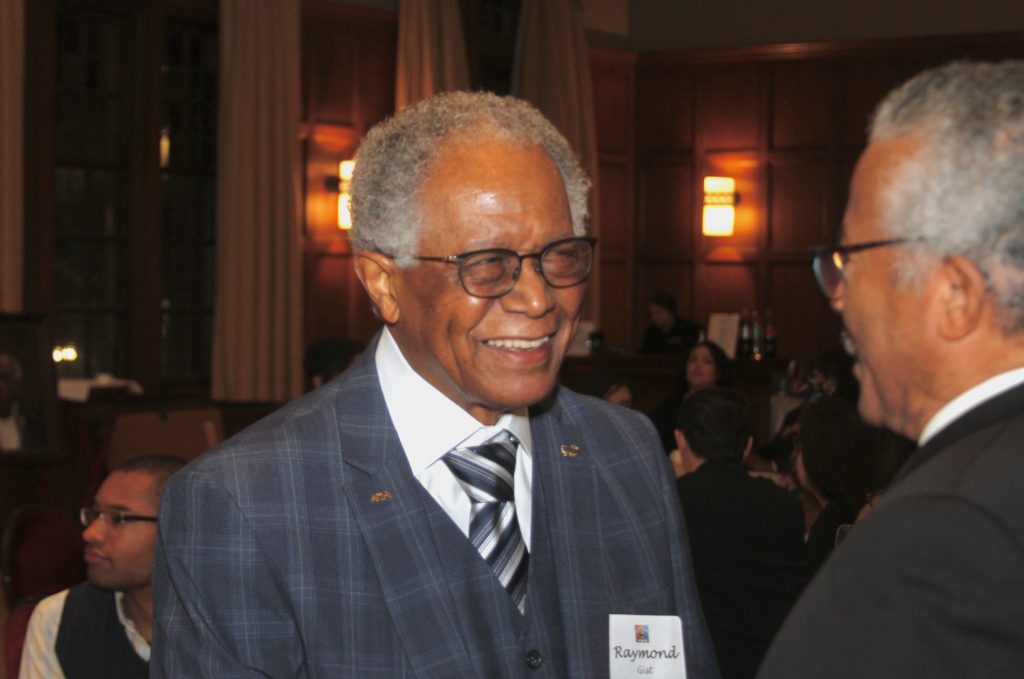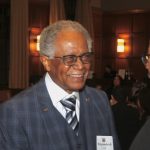Alumni Profile: Dr. Raymond Gist (DDS 1966) – A pioneer of diversity in dentistry continues to advocate for the next generation of dentists11 min read

_______________________________
This profile is one in an ongoing series highlighting School of Dentistry alumni, donors and students.
_______________________________
Ann Arbor, Mich., Feb. 9, 2023 – Dr. Raymond Gist has long since reached the point where he could retire from dentistry and be entitled to sit back and reflect on his rewarding and pioneering career, all while relaxing at his favorite golf courses more often.
But that’s not really Gist’s style. At age 80, with his trademark broad smile, he still sees patients three days a week at his dental office in Flint, Michigan, and he continues to serve on various boards related to dentistry and other community service. There are too many people in need of dental care, he says, and many of their needs are more pressing these days because regular dentist visits were often interrupted for a year or two by the COVID-19 pandemic.
So he still is offering his general dentistry skills just as he has since he graduated from the University of Michigan School of Dentistry in 1966. He spent two years as a dentist in the U.S. Air Force in the Philippines during the Vietnam War, then returned to his hometown of Flint to work in a community clinic for a couple of years before opening his private practice. That’s 57 years of helping thousands of people achieve better oral health and, thus, overall health. He says several of his patients like to brag that they are his longest active patient, which is debatable, but there’s no doubt about his value to the people of Flint who have been coming to see him for decades.
Gist’s contributions to dentistry go far beyond his longtime loyalty to his patients. He also decided early on in his career to do his best to make dentistry a better profession and he recorded several significant “firsts” in doing so. He started by joining the local dental society in Genesee County and over time became involved in the Michigan Dental Association (MDA). He said he found his participation in policy issues at both the local and state level gratifying, particularly working with state legislators on ways to improve dentistry regulations that ultimately improved healthcare for patients across the state.
As Gist took on more committee assignments and made more connections within the state dentistry community, he was elected president of the Genesee District Dental Society, the first Black dentist to lead the organization. Success at that level led to leadership positions at the state level, first as a trustee of the MDA board and then his election by the membership as president of the MDA for the 2003-04 term. He was the first Black president in what was then the 147-year history of the organization founded in 1856. After a successful tenure leading the MDA and its initiatives, six years later a group of his Michigan colleagues advocated for his candidacy for president of the American Dental Association (ADA). Again he was elected and again he made history, as the first Black president of the ADA since its founding in 1859.
Beyond the traditional leadership duties for its 157,000 members, one of Gist’s most important accomplishments during his ADA presidency was reaching out to the other major national dentistry organization – the National Dental Association (NDA), comprised primarily of Black dentists. In 2010, Gist worked with the rest of the ADA leadership to write a letter of apology to the NDA for past membership discrimination that had barred black dentists from the ADA for decades, continuing as late as the 1970s among some state chapters around the country, primarily in the South. The impetus for the letter came from a diversity summit by the ADA two years after the American Medical Association created a similar apology for Black doctors across the country.
Gist’s letter said in part: “The ADA recognizes that all African American dentists’ lives have been affected by our nation’s discrimination history. In order to build a stronger, collaborative platform for our future accomplishments, the American Dental Association acknowledges its past mistakes and apologizes to the members of the National Dental Association and to all African-American dentists. We cannot and must not forget the past, yet commit to move forward collaboratively to ensure the strength of our profession for those currently practicing and for those who will come after us.”

That last rejoinder – “those who will come after us” – continues to concern Gist as he considers ways that dentistry and dental schools can become more racially diverse. Viewed from his history as the only Black dental student who graduated in his U-M DDS Class of 1966, Gist said the landscape for minority dental students is much improved today. Both the ADA and MDA have made significant commitments to diversity, equity and inclusion issues and education in recent years. National statistics for dentistry and dental schools show the profession has made important diversity gains in terms of female, Hispanic and Asian practitioners. However, Blacks – especially Black men – and American Indians remain underrepresented compared to their representation in the general population.
While the commitment of dentistry organizations is crucial to improving diversity, Gist believes there are several areas for improvement that need the involvement of all the profession’s constituents working together, including individual dentists and dental schools. Issues include better recruitment of minority students so that they are “in the pipeline” toward dental school; reduction of the enormous debt accumulated by many dental students; and more involvement of minority dentists in professional organizations, particularly in high-profile leadership positions.
Gist advocates for what he calls “more exposure” in a couple of ways. First, the profession can do a better job of recruiting young students to make them aware that dentistry is a great profession and to explain what they need to accomplish academically to get there. That effort can start as early as elementary school with presentations where students of color learn from “a dentist who looks like them” that dentistry is a career option. Like many dentists, Gist has allowed countless high school and college students to shadow him in his office over the years. He fondly recalls a young woman of color who rode her scooter to his office for her shadowing visits. Over time, as she saw the various facets of his dental office operation, she grew increasingly excited about the profession. She was later accepted to the U-M dental school and is today a practicing dentist, just one example of how dentists can encourage students by their example of success.
A second aspect of “exposure” that is important, Gist said, is for minority dentists to become involved in professional organizations as quickly after graduation as they can, which should be the same goal for all young dentists. It is important that they move beyond basic membership to become involved in committee work and strive for leadership positions that naturally call attention to their professional advancement. That commitment of time is sometimes difficult in the early years of their career because of their debt load from dental school and the need to keep their focus on building their practice and financial model. Gist said he feels fortunate that debt wasn’t the issue in his era that it is today, so he was able to more quickly engage in dental organizations, which led to his high-profile leadership positions.
“All of this plays a role in building up dentistry and diversity in dentistry,” he said. “Once they get that degree and have an active practice and get comfortable financially, then they can work with the ADA and MDA because those organizations are looking for better pathways for people of color. Being active and gaining publicity and exposure through leadership is important so that others can see us and what we do. By seeing our smiles and how much we enjoy being active, it is sort of a welcoming sign for others.”

Gist recalls that the number of Black dentists joining the ADA “practically skyrocketed” during his term as president of the ADA, which he attributes to the considerable “first-ever” publicity it generated. That spurt later leveled off and now, 13 years after his term, he remains the only Black to have led the ADA. Five years after Gist was president of the MDA, Joanne Dawley, also a U-M alumna (DDS 1980), became the second and only other Black MDA president in the organization’s history.
Gist’s story is a remarkable accomplishment for someone who grew up in a family of eight children in what he calls a “distressed neighborhood” in inner-city Flint in the 1950s. No one in Gist’s family had ever gone to college. He remembers family members being dismissive when he first announced his intention to go to college and pursue dentistry. His determination never wavered as he found a way around his family’s very limited financial resources to meet the pre-dental academic admission requirements by going year-round at the community college in Flint.
By the time he finished his role with the ADA many years later, it had taken him to more than 40 of the United States and countries on four continents. While Gist understands that his story is inspirational to other Blacks interested in dentistry, he would like to be joined by many other similar stories from around the country as young minority dentists fill the ranks of dental schools to a greater degree.
Ultimately, the issue of needing more diversity in dentistry is about patients, he says. Studies have shown that minority dentists are more likely to choose to practice in underserved communities, which helps narrow the gap in quality oral healthcare across social-economic and geographic divides. Another factor that needs to be addressed is improving healthcare insurance so that a wider variety of dental procedures are covered for more people. Gist sees these sorts of problems in his work on the board of the Genesee Health Plan, which does excellent work treating underserved patients but has financial limitations. He is also on the boards of Delta Dental and its foundation, which are addressing diversity and insurance improvements as well.
“There is so much to be done for patients,” he said. “The need is so great. What we always emphasize is that the disease process starts with the mouth and it travels from there. If gum tissues are under good management, then it not only saves a lot of teeth, but it enhances overall health dramatically.”
That ability to provide dental treatment for so many people in so many ways over the course of his career has been fulfilling, he says, and that’s why he has no plans to retire at the moment. However, he is beginning to consider who might want to take over his practice. Regardless of when he treats his final patient, he will always continue to advocate for the advancement of the profession that has served him so well and that he has served so well.
“Things have improved, but there is a lot more to be done about diversity and inclusion,” he said. “It’s promising but it could be faster as far as I’m concerned.”
###
The University of Michigan School of Dentistry is one of the nation’s leading dental schools engaged in oral healthcare education, research, patient care and community service. General dental care clinics and specialty clinics providing advanced treatment enable the school to offer dental services and programs to patients throughout Michigan. Classroom and clinic instruction prepare future dentists, dental specialists and dental hygienists for practice in private offices, hospitals, academia and public agencies. Research seeks to discover and apply new knowledge that can help patients worldwide. For more information about the School of Dentistry, visit us on the Web at: www.dent.umich.edu. Contact: Lynn Monson, associate director of communications, at [email protected], or (734) 615-1971.

